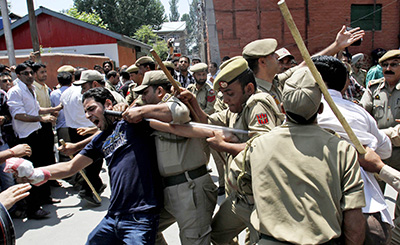Early this month, newspaper offices in Indian-controlled Kashmir received a note warning journalists to be more supportive of the Kashmir independence movement, according to the leading national daily, The Times of India, citing a news agency in the state’s summer capital, Srinagar. No militants took responsibility this time, but in mid-March insurgent groups issued a joint message that urged journalists to “highlight the pain and suffering of Kashmiris because of oppressive state policies.”
Facing intimidation from multiple sides is all part of being a journalist in the state of Jammu and Kashmir. Just last November, officers of the Central Reserve Police Force, a government security agency, assaulted journalists on assignment in downtown Srinagar, according to New Delhi-based Tehelka magazine.
Ever since the region was first wracked by conflict 23 years ago, the media have faced attacks from militant groups and state agencies. At least 10 journalists have been killed in the region since 1992–mostly by unidentified assailants–and many others have been wounded. Journalists have been jailed, photographers beaten, equipment seized, telephones tapped, websites blocked, emails hacked, social networking sites scrutinized, and text messages banned.
“The media, while they are not being targeted or harassed systematically as they were 20 years ago, continue to be vulnerable,” veteran journalist Yusuf Jameel told me by telephone from Srinagar. In 1995, Jameel, then working for the BBC, received a parcel bomb sent to his home. The ensuing blast killed a friend and injured Jameel.
Despite these woes, the number of media outlets in Kashmir continues to grow. Nearly 900 publications are registered today in the state of Jammu and Kashmir, up from 30 in 1989, according to the website of the Registrar of Newspapers for India. For the first time, a national English-language daily published from Chandigarh, The Tribune, has opened local editions, first in Jammu and more significantly last week, in Srinagar itself. Local and national news channels have proliferated, as have websites and bloggers–reflecting diversity in the news media and hinting at its potential robustness.
But expanding news media does not necessarily mean that the press is free. The scrutiny the media face from state and militant groups is in direct proportion to the level of unrest in the region. In June, locals commemorated the summer of 2010, when the state responded to increasingly violent demonstrations by imposing a curfew. Back then, newspapers distribution was halted for a total of 30 days, cable services were disrupted, and journalists were confined to their homes, despite having valid curfew passes.
Two years later, while the news media are not burdened by outright censorship, they continue to be hindered by what Shujaat Buhkari, editor of the newly launched daily Kashmir Rising, calls “invisible pressures.” High on the list are the obstacles to reliable information. Public officials, thanks to national security laws, are under no obligation to provide reports, give statistics, or impart up-to-date, accurate information to journalists. National security legislation such as the Public Safety Act, established in 1978, has even been used to incarcerate journalists.
“So-called national security far outweighs the public’s right to know,” says Anuradha Bhasin, executive editor of Kashmir Times, one of the oldest newspapers of Jammu and Kashmir. “Even if any information is given, it will often be slanted. For small-time reporters located in rural areas or in the border regions, it becomes especially difficult to resist such pressure. Then the army becomes both the guardian and the guide.”
As Jameel told me: “Typically, reporting in any given situation, the reporter will have three versions: The ‘official’ version; the militant group’s version; and the eyewitness version.” Thus, news media credibility can be a casualty. “Media consumers in the Valley are often skeptical about the news they receive,” says Bashaarat Masood, the Srinagar-based correspondent of The Indian Express. When the public reads a report they often ask themselves who has given the story–intelligence agencies or militant groups? Masood adds: “The reality is that in a conflict situation, as a reporter, you need to balance the story with both sides. So you are always looking at how to find that threshold, that fine balance.”
There are other obstacles. Government organizations can withhold advertising–one of the main sources of revenue for local media houses–in order to pressure an independent outlet. Local newspapers and news channels, which officials often consider sympathetic to the cause of the resistance, or even anti-Indian, are particularly vulnerable.
Bhukari, whose paper, along with four others, was banned from receiving government advertising, has written extensively on this subject. “I was told that my paper would not get government advertising, as it preaches secessionism. I took the matter up with the Central Home Minister, but nothing has happened,” Bhukari said.
Bhasin recounted an episode from seven years ago to illustrate the state’s ongoing determination to punish critical news outlets. “When The Kashmir Times wrote a story how the then-state’s chief minister’s daughter-in-law had bagged a lucrative contract, the paper’s electricity supply was ‘mysteriously’ disconnected for six months,” she recalled.
In this and other important respects, not enough has changed in Jammu and Kashmir.
